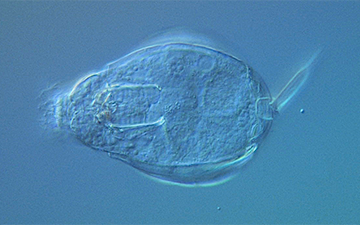The rotifers (Rotifera, commonly called wheel animals) make up a phylum of microscopic and near-microscopic pseudocoelomate animals. They were first described by Rev. John Harris in 1696, and other forms were described by Anton van Leeuwenhoek in 1703.[1] Most rotifers are around 0.1–0.5 mm long (although their size can range from 50 μm to over 2 mm),[2] and are common in freshwaterenvironments throughout the world with a few saltwater species; for example, those of genus Synchaeta. Some rotifers are free swimming and truly planktonic, others move by inchworming along a substrate, and some are sessile, living inside tubes or gelatinous holdfasts that are attached to a substrate. About 25 species are colonial (e.g., Sinantherina semibullata), either sessile or planktonic. Rotifers are an important part of the freshwater zooplankton, being a major foodsource and with many species also contributing to the decomposition of soil organic matter.[3] Most species of the rotifers are cosmopolitan, but there are also some endemic species, like Cephalodella vittata to Lake Baikal.[4] Recent barcodingevidence, however, suggests that some ‘cosmopolitan’ species, such as Brachionus plicatilis, B. calyciflorus, Lecane bulla, among others, are actually species complexes.[5]
In some recent treatments, rotifers are placed with acanthocephalans in a larger clade calledSyndermata.
(From: Wikipedia, July 2015)




